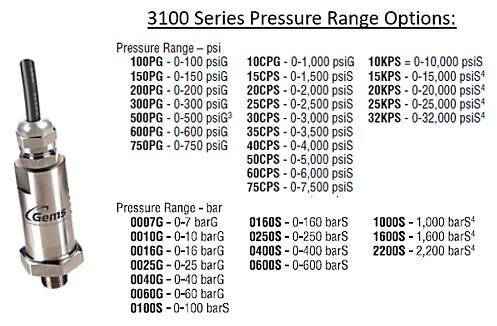Gems pressure sensors are designed to measure pressure in pounds per square inch (PSI). We are all familiar with PSI in our everyday lives. Car or bike tires, spray washers, and inflatable balls for sports are a few examples where PSI ratings are regularly seen. In industry it is common to see pressure measured in Gauge PSI (PSIG) or Absolute PSI (PSIA).
The difference between PSIG and PSIA is what they use as their reference pressure. The reference is the base line from which the measured pressure is compared. PSI Absolute is the measured pressure value compared to a full vacuum or “true zero”.” PSI Gauge is the measured pressure value relative to the current ambient pressure of the atmosphere. At sea level that is about 14.7 PSI. With this in mind we know that 0 PSIG equals 14.7 PSIA at sea level as shown in the graph below.

The way Gems pressure sensors provide the different measurement types is from the internal design of the area behind the diaphragm. The diaphragm is what comes into direct contact with the application pressure to be measured. With Gauge pressure the area behind the diaphragm is either vented to atmosphere or can be sealed but has trapped air. Therefore, the reference pressure (behind diaphragm) used against the sensed pressure (at sensing port) will cancel each other out when the sensing port is open to atmosphere. Absolute pressure requires the area behind the diaphragm to have all pressure evacuated creating a total vacuum. The application pressure will be measured in relation to this true zero vacuum.

Selecting Measurement Type:
It is important to choose the correct measurement type based on your application. PSIA with Absolute pressure works well when higher accuracy is required with large temperature swings and/or changes in elevation. Those conditions have an effect on the ambient atmospheric pressure, and with PSIA reference being full vacuum it ignores any changes in temperature or elevation. PSIG with Gauge pressure is used when changes in atmospheric pressure may affect the process like in an open tank. Since the process is influenced by the ambient atmospheric conditions, the PSIG is the best option to compensate for the changes.
On specific models, like the 3100 Series, Gems sensors offers two different Gauge pressure options, Vented and Sealed. Vented Gauge (PSIG) behaves like the open tank example above. Your meter or dial will always read zero when the sensing port is open to atmosphere. With the application pressure always referenced against outside atmospheric pressure, the changes in ambient conditions will cancel each other out. Sealed Gauge is not open to outside atmospheric pressure, but instead has approximately 14.7 PSI sealed in behind the diaphragm. Sealed Gauge sensors (PSIS) are better suited for high pressure ranges 1500 PSI or above. Many high pressure applications are not greatly influenced by changes in temperature, so a variable reference from 14.7 is not required. The Sealed Gauge is also needed where it is not possible to vent at all (e.g. submerged).

Although this guide has referenced PSI for pressure measurement, it is important to note that you may also see “bar” used for pressure (very common outside US). Nearly all Gems pressure products offer measurement in bars. 1 bar is equal to approximately 14.5 PSI.
Other types of pressure measurement include:
Vacuum pressure:
- Measures anything below 14.7 PSIA
- Units = PSIV (pounds per square inch vacuum), or ” Hg (inches of mercury)
- Application - Vacuum pump with suction cups for pick & place
Differential pressure:
- Measures the difference between any two pressures
- Units = PSID (pounds per square inch differential)
- Application - Inline filter condition monitoring
Compound pressure:
- Measures from full vacuum (true zero) through positive pressure
- Units = PSIC (pounds per square inch compound)
- Application - Autoclave using both vacuum and positive pressure for drying and sterilization
The information in this guide should help you choose the best measurement type for your application.
For Gems Sensors complete line of pressure products covering all of these measurements follow the link HERE.
For additional pressure related technical and troubleshooting information click HERE.
 SEARCH OUR RESOURCE CENTER
SEARCH OUR RESOURCE CENTER

